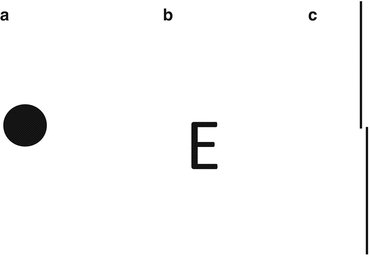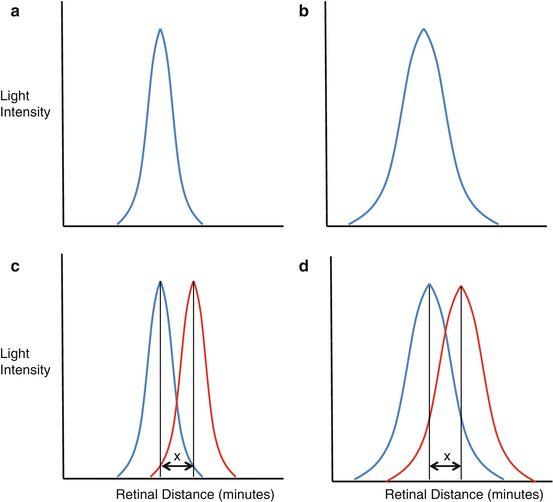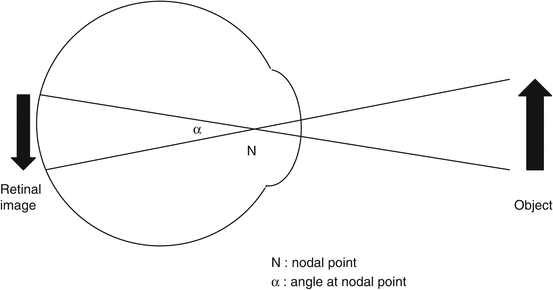(1)
University of Sydney, Sydney, Australia
Overview
Visual acuity (VA) is a measure of keenness of sight.
A high acuity implies a low threshold to detecting the stimulus.
VA is affected by:
(a)
Optical factors that influence the quality of light reaching the retina
Visual Angle
Types of Visual Acuity (Table 19.1; Fig. 19.2)
Minimum visible | Minimum resolvable (ordinary visual acuity) | Minimum discriminable (hyperacuity) | |
|---|---|---|---|
Task | Determine presence or absence of a target | Distinguish features of target (e.g., form, shape, pattern) | Determine relative location of >1 visible features |
Example | Is there a dot? | Is that an E or an F? | Is the upper line to the left or right of the lower line? |
Influential stimulus factors | Contrast Size | Contrast Size Spacing | Relative location Vertical separation |
Influential physiological factors | Sensitivity of photoreceptors to light | Density of foveal photoreceptors | Neural processing: Retinal ganglion cell center surrounds antagonist receptive fields Cortical linear receptive fields |
Best threshold | ~1 s of arc | ~1 min of arc | ~3 s of arc |

Fig. 19.2
(a) Minimal visible; (b) minimal resolvable; (c) minimal discriminable visual acuity
There are various types of visual acuity that differ according to visual task and threshold.
(i)
Minimum visible
This refers to distinguishing details (form, shape, pattern) of a visual stimulus [1, 5].
(iii)
Minimal discriminable (hyperacuity, vernier)
This refers to detecting a discontinuity of alignment (relative location of more than one object) [6].
It has a lower threshold than minimum resolvable VA and is not limited by foveal photoreceptor density.
Hyperacuity is less affected by optical blur than minimal resolvable VA [10].
Factors Influencing Visual Acuity
1.
The point spread function
The point spread function defines how the optical components (clear media) of the eye process light.
Consider light from a distant point source image (e.g., a star).
Due to imperfections of the optics of the eye, the light does not reach the retina as a point; rather the light falls on the retina in a distribution similar to that shown in Fig. 19.3a, b [11, 12].

Fig. 19.3
The point spread function. (a) Good optical transmission; (b) poorer optical transmission than in a; (c) two points at a fixed retinal distance x can be discriminated by system (a); (d) at the same distance x the two points cannot be discriminated by the poorer optical system (b) (Based on Levi [2])
2.
Optical factors
Optical factors affect the point spread function of the retinal image.
(i)
(iii)
3.
Physiologic factors
Get Clinical Tree app for offline access

(i)
Foveal cone density
The density of foveal cone packing is a critical determinant of fine visual resolution.
This is because the more closely packed the photoreceptors, the better the visual system’s ability to discriminate differences in light distribution [5, 21].
At least two cones for each cycle of a test sinusoid are required for good resolution (Fig. 19.4) [2].
Human foveal cones are separated by approximately 30 s of arc; hence, MAR is 1 min [5].
(ii)
(iii)
(iv)
Contrast (see Chap. 20. Contrast Sensitivity)
Contrast is the difference between stimulus and background illumination.
VA is generally tested under conditions of high contrast, e.g., black letters on a white screen.
Contrast sensitivity is our ability to detect a change in luminance over a uniform background.
It is best described using a spatial contrast sensitivity function reflecting contrast detection threshold at different spatial frequencies [26].
Individuals with subnormal contrast sensitivity (e.g., from cataract) can have normal or reduced VA.
(v)
Retinal eccentricity
(vii)
Duration of exposure (see Chap. 22. Temporal Properties of Vision)
For most stimuli (except for very brief exposures), VA is independent of stimulus duration.
The influence of brief duration is related to overall stimulus visibility and can be reduced by increasing stimulus contrast or illumination.

Stay updated, free articles. Join our Telegram channel

Full access? Get Clinical Tree




